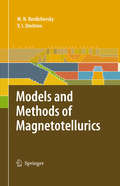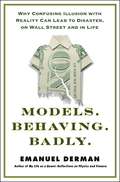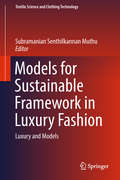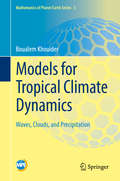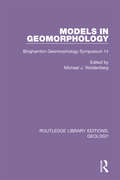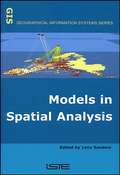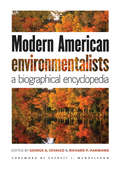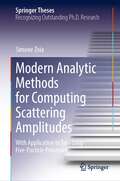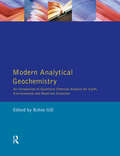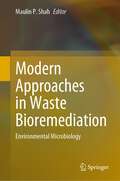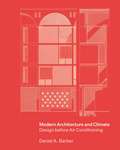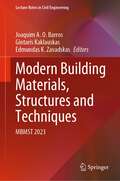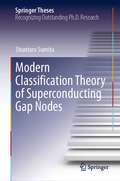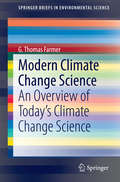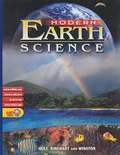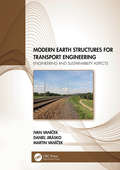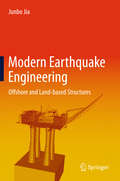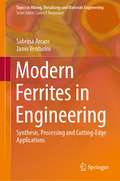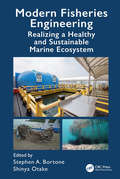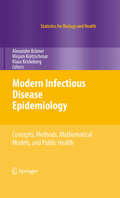- Table View
- List View
Models and Methods of Magnetotellurics
by Mark N. Berdichevsky Vladimir I. DmitrievMagnetotellurics is finding increasing applications for imaging electrically conductive structures below the Earth`s surface - in both industrial and academic research projects. In this book the authors provide a systematic approach to understanding the modern theory of ill-posed problems which is essential to making confident meaningful interpretations of magnetotelluric and magnetovariational soundings. The interpretation is conducted in an interactive way.
Models.Behaving.Badly.
by Emanuel DermanEmanuel Derman was a quantitative analyst (Quant) at Goldman Sachs, one of the financial engineers whose mathematical models usurped traders' intuition on Wall Street. The reliance traders put on such quantitative analysis was catastrophic for the economy, setting off the series of financial crises that began to erupt in 2007 with the mortgage crisis and from which we're still recovering. Here Derman looks at why people--bankers in particular--still put so much faith in these models, and why it's a terrible mistake to do so.Though financial models imitate the style of physics by using the language of mathematics, ultimately they deal with human beings. Their similarity confuses the fundamental difference between the aims and possible achievements of the phsyics world and that of the financial world. When we make a model involving human beings, we are trying to force the ugly stepsister's foot into Cinderella's pretty glass slipper. It doesn't fit without cutting off some of the essential parts. Physicists and economists have been too enthusiastic to recognize the limits of their equations in the sphere of human behavior--which of course is what economics is all about. Models.Behaving.Badly includes a personal account Derman's childhood encounter with failed models--the utopia of the kibbutz, his experience as a physicist on Wall Street, and a look at the models quants generated: the benefits they brought and the problems they caused. Derman takes a close look at what a model is, and then he highlights the differences between the success of modeling in physics and its relative failure in economics. Describing the collapse of the subprime mortgage CDO market in 2007, Derman urges us to stop relying on these models where possible, and offers suggestions for mending these models where they might still do some good. This is a fascinating, lyrical, and very human look behind the curtain at the intersection between mathematics and human nature.
Models for Sustainable Framework in Luxury Fashion: Luxury And Models (Textile Science And Clothing Technology Ser.)
by Subramanian Senthilkannan MuthuThis book highlights the models developed to create a sustainable framework suitable for luxury in the textile sector and the innovative attempts in the luxury fashion and fabrics industry. The three chapters in this book discuss these issues by means of case studies and the future of such models.
Models for Tropical Climate Dynamics: Waves, Clouds, and Precipitation (Mathematics of Planet Earth #3)
by Boualem KhouiderThis book is a survey of the research work done by the author over the last 15 years, in collaboration with various eminent mathematicians and climate scientists on the subject of tropical convection and convectively coupled waves. In the areas of climate modelling and climate change science, tropical dynamics and tropical rainfall are among the biggest uncertainties of future projections. This not only puts at risk billions of human beings who populate the tropical continents but it is also of central importance for climate predictions on the global scale. This book aims to introduce the non-expert readers in mathematics and theoretical physics to this fascinating topic in order to attract interest into this difficult and exciting research area. The general thyme revolves around the use of new deterministic and stochastic multi-cloud models for tropical convection and convectively coupled waves. It draws modelling ideas from various areas of mathematics and physics and used in conjunction with state-of-the-art satellite and in-situ observations and detailed numerical simulations. After a review of preliminary material on tropical dynamics and moist thermodynamics, including recent discoveries based on satellite observations as well as Markov chains, the book immerses the reader into the area of models for convection and tropical waves. It begins with basic concepts of linear stability analysis and ends with the use of these models to improve the state-of-the-art global climate models. The book also contains a fair amount of exercises that makes it suitable as a textbook complement on the subject.
Models in Geomorphology: Binghamton Geomorphology Symposium 14 (Routledge Library Editions: Geology #23)
by Michael J. WoldenbergThis book, first published in 1985, arises from the 14th Binghamton Geomorphology Symposium. The chapters here illustrate the use of models in various areas of research in geomorphology.
Models in Spatial Analysis (Wiley-iste Ser.)
by Lena SandersThis title provides a broad overview of the different types of models used in advanced spatial analysis. The models concern spatial organization, location factors and spatial interaction patterns from both static and dynamic perspectives. Each chapter gives a broad overview of the subject, covering both theoretical developments and practical applications. The advantages of an interdisciplinary approach are illustrated in the way that the viewpoint of each of the individual disciplines are brought together when considering questions relevant to spatial analysis. The authors of the chapters come from a range of different disciplines (geography, economy, hydrology, ecology, etc.) and are specialists in their field. They use a range of methods and modeling tools developed in mathematics, statistics, artificial intelligence and physics.
Modern American Environmentalists: A Biographical Encyclopedia
by George A. Cevasco Richard P. HarmondModern American Environmentalists profiles the lives and contributions of nearly 140 major figures during the twentieth-century environmental movement. Included are iconic environmentalists such as Rachel Carson, E. O. Wilson, Gifford Pinchot, and Al Gore, and important but less expected names, including John Steinbeck and Allen Ginsberg. The entries recount how each individual became active in environmental conservation, detail his or her significant contributions, trace the influence of each on future efforts, and discuss the person's legacy. The individuals selected for the book displayed either an unparalleled commitment to the conservation, preservation, restoration, and enhancement of the natural environment or made a major contribution to the growth of environmentalism during its first century. With a foreword by environmental historian Everett I. Mendolsohn, a time line of key environmental events, a bibliography of groundbreaking works, and an index organized by specialization, this biographical encyclopedia is a handy and complete guide to the major people involved in the modern American environmental movement.
Modern Analytic Methods for Computing Scattering Amplitudes: With Application to Two-Loop Five-Particle Processes (Springer Theses)
by Simone ZoiaThis work presents some essential techniques that constitute the modern strategy for computing scattering amplitudes. It begins with an introductory chapter to fill the gap between a standard QFT course and the latest developments in the field. The author then tackles the main bottleneck: the computation of the loop Feynman integrals. The most efficient technique for their computation is the method of the differential equations. This is discussed in detail, with a particular focus on the mathematical aspects involved in the derivation of the differential equations and their solution. Ample space is devoted to the special functions arising from the differential equations, to their analytic properties, and to the mathematical techniques which allow us to handle them systematically. The thesis also addresses the application of these techniques to a cutting-edge problem of importance for the physics programme of the Large Hadron Collider: five-particle amplitudes at two-loop order. It presents the first analytic results for complete two-loop five-particle amplitudes, in supersymmetric theories and QCD. The techniques discussed here open the door to precision phenomenology for processes of phenomenological interest, such as three-photon, three-jet, and di-photon + jet production.
Modern Analytical Geochemistry: An Introduction to Quantitative Chemical Analysis Techniques for Earth, Environmental and Materials Scientists (Longman Geochemistry Series)
by Robin GillA comprehensive handbook of analytical techniques in geochemistry which provides the student and the professional with an understanding of the wide spectrum of different analytical methods that can be applied to Earth and environmental materials, together with a critical appreciation of their relative merits and limitations.
Modern Apartment Design
by Guy MarriageModern Apartment Design provides guidelines to the design of modern apartment buildings as well as a summation of current cutting-edge practice in engineered timber construction. The book covers a brief history of apartment buildings around the world, with a broad outline of different types of apartment blocks. It has a strong focus on the design and actual construction of apartment buildings, especially those utilising mass timber, such as cross-laminated timber and laminated veneer lumber. It also features six Case Study chapters from industry-leading practitioners in the area, enabling best practice in architecture and engineering of these new apartment building types to be more widely understood and propagated worldwide. The fully illustrated, full-colour case studies span the globe and include: Clearwater Quay in Christchurch, New Zealand (Pacific Environments NZ); Wynyard Central East 2 in Auckland, New Zealand (Architectus); Dalton Works in London, UK (Waugh Thistleton Architects); Mjøstårnet, Brumunddal, Norway (Voll Arkitekter); Brock Commons Tallwood House student housing in Vancouver, Canada (Acton Ostry Architects); and Regensbergstrasse apartments in Zurich, Switzerland (Dreicon). The book will be of great interest to architects and architecture students.
Modern Applications of Geotechnical Engineering and Construction: Geotechnical Engineering and Construction (Lecture Notes in Civil Engineering #112)
by Mahdi O. Karkush Deepankar ChoudhuryThis book contains select papers from the International Conference on Geotechnical Engineering Iraq discussing the challenges, opportunities, and problems of application of geotechnical engineering in projects. The contents cover a wide spectrum of themes in geotechnical engineering, including but not limited to sustainability & geotechnical engineering, modeling of foundations & slope stability, seismic analysis & soil mechanics, construction materials, and construction & management of projects. This volume will prove a valuable resource for practicing engineers and researchers in the field of geotechnical engineering, structural engineering, and construction and management of projects.^
Modern Approaches in Waste Bioremediation: Environmental Microbiology
by Maulin P. ShahThe book highlights the importance of newly developed bioremediation technologies in industrial waste treatment to clean up the environment from pollution caused by human activities. It assesses the potential application of several existing bioremediation techniques and introduces new emerging and application-based technologies.This technology includes several techniques such as bio-stimulation, bio-generation, bioaccumulation, biosorption, physical correction and rhyming-emission. This book describes the limitations and challenges associated with some generally accepted bioremediation strategies and evaluate the possible applications of these corrective strategies to eliminate toxic pollutants from the environment through integrated Technologies in Industrial wastewater treatment.
Modern Architecture and Climate: Design before Air Conditioning
by Daniel A. BarberHow climate influenced the design strategies of modernist architectsModern Architecture and Climate explores how leading architects of the twentieth century incorporated climate-mediating strategies into their designs, and shows how regional approaches to climate adaptability were essential to the development of modern architecture. Focusing on the period surrounding World War II—before fossil-fuel powered air-conditioning became widely available—Daniel Barber brings to light a vibrant and dynamic architectural discussion involving design, materials, and shading systems as means of interior climate control. He looks at projects by well-known architects such as Richard Neutra, Le Corbusier, Lúcio Costa, Mies van der Rohe, and Skidmore, Owings, and Merrill, and the work of climate-focused architects such as MMM Roberto, Olgyay and Olgyay, and Cliff May. Drawing on the editorial projects of James Marston Fitch, Elizabeth Gordon, and others, he demonstrates how images and diagrams produced by architects helped conceptualize climate knowledge, alongside the work of meteorologists, physicists, engineers, and social scientists. Barber describes how this novel type of environmental media catalyzed new ways of thinking about climate and architectural design.Extensively illustrated with archival material, Modern Architecture and Climate provides global perspectives on modern architecture and its evolving relationship with a changing climate, showcasing designs from Latin America, Europe, the United States, the Middle East, and Africa. This timely and important book reconciles the cultural dynamism of architecture with the material realities of ever-increasing carbon emissions from the mechanical cooling systems of buildings and offers a historical foundation for today’s zero-carbon design.
Modern Building Materials, Structures and Techniques: MBMST 2023 (Lecture Notes in Civil Engineering #392)
by Joaquim A. O. Barros Gintaris Kaklauskas Edmundas K. ZavadskasThis book gathers the latest advances, innovations and applications in the field of sustainable construction materials and structures, as presented by leading international researchers and engineers at the 14th International scientific conference “Modern Building Materials, Structures and Techniques” (MBMST 2023), held in Vilnius, Lithuania, on 5–6 October 2023. It covers topics such as modern building materials and their production technologies; investigation and design of reinforced concrete, steel, glass, timber and composite structures; innovative calculation techniques for bridges; geotechnics; new building technologies and management; and building information modelling. The contributions, which were selected through a rigorous international peer-reviewed process, share exciting ideas that will spur novel research directions and foster new multidisciplinary collaborations.
Modern Classification Theory of Superconducting Gap Nodes (Springer Theses)
by Shuntaro SumitaThis book puts forward a modern classification theory for superconducting gap nodes, whose structures can be observed by experiments and are essential for understanding unconventional superconductivity. In the first part of the book, the classification method, based on group theory and K theory, is introduced in a step-by-step, pedagogical way. In turn, the latter part presents comprehensive classification tables, which include various nontrivial gap (node) structures, which are not predicted by the Sigrist-Ueda method, but are by the new method. The results obtained here show that crystal symmetry and/or angular momentum impose critical constraints on the superconducting gap structures. Lastly, the book lists a range of candidate superconductors for the nontrivial gap nodes. The classification methods and tables presented here offer an essential basis for further investigations into unconventional superconductivity. They indicate that previous experimental studies should be reinterpreted, while future experiments should reflect the new excitation spectrum.
Modern Climate Change Science
by G. Thomas FarmerComposed of two extensive sections, this book surveys important work in climate change science, mainly in the United States, and introduces contributions to the body of science that have arrived on the scene between January 2013 and February 2014. The opening section offers a broad examination of contemporary climate change science, with subsections on the Intergovernmental Panel on Climate Change (IPCC); Earth's energy imbalance and energy flow; carbon dioxide's role in the greenhouse effect; climate forcing, and climate feedbacks; Charles David Keeling and the Keeling Curve; the interfaces of atmosphere with oceans and land; paleoclimates and paleoclimatology; rising sea level; melting glaciers; deforestation; desertification; more violent storms, animal and human migration, extinction of species and more. The second section reviews and assesses the newest contributions to the body of research. Among the topics discussed are current and recent research on rising temperatures; the BEST study; the Global Historical Climatology Network (GHCN) and the National Climatic Data Center (NCDC); current and recent research on climate models, new research on global warming 56 million years ago; ecosystem impacts, projections of future climate and more. This book can be considered a bridge between the volumes of Farmer and Cook's Climate Change Science: A Modern Synthesis, as it arrives between the release of the first volume on the Physical Climate (2013) the second, on Earth's climate history, which is now in preparation. The book benefits a wide audience as its survey of the science of climate change provides an introduction to the subject and a discussion of current research in the field. The book may be used as a refresher for those who have had prior courses in climate science and related fields. Each chapter includes a comprehensive list of references for subjects discussed in the text.
Modern Earth Science
by Robert J. Sager William L. Ramsey Clifford R. Phillips Frank M. WatenpaughStudying the earth is like putting together a complex jigsaw puzzle that is made up of pieces that are constantly changing shape. As time passes, many of the pieces change so much they don't even resemble their original shape.
Modern Earth Science
by Robert J. Sager William L. Ramsey Clifford R. Phillips Frank M. WatenpaughStudying the earth is like putting together a complex jigsaw puzzle that is made up of pieces that are constantly changing shape. As time passes, many of the pieces change so much they don't even resemble their original shape.
Modern Earth Structures for Transport Engineering: Engineering and Sustainability Aspects
by Ivan Vaníček Daniel Jirásko Martin VaníčekNowadays, demands on modern civil engineering structures require not only safe technical solutions, but also additional approaches, involving ecological, sociological and economical aspects. This book reacts on these new requirements with a focus on earth structures for transport engineering, mainly for motorways and railways. Technical demands have to be adequately related to the risk with which the design and execution are connected. Soil used for the construction, together with subsoil, are natural materials with a high degree of inhomogeneity. Therefore, the risk when constructing with such materials is much higher than for structures utilizing man-made materials. The engineering approach is firstly focused on the geotechnical risk identification and subsequently on the reduction of this risk. Geotechnical risk is linked to the uncertainties for individual phases of the design and construction processes. Ground model, geotechnical design model, calculation model and structure execution are the main phases of the above-mentioned processes. Risk reduction involves the lowering of the range of uncertainties for individual phases, guaranteeing safe and optimal technical solutions. Eurocode 7 "Geotechnical design" creates a general frame of this risk identification and reduction approach. Earth structures are offering great opportunities for sustainability approach. Therefore, the possibilities how to decrease consumption of land (greenfields), energy and natural aggregates are at the centre of interest. In parallel to sustainability, the principles of availability and affordability for transport infrastructures are discussed. The main aim there is to eliminate the impact of interaction of the transport infrastructure with natural and man-made hazards, thus guaranteeing long-term functionality. This book will be of interest to specialists responsible for transport infrastructure planning, investors (project owners) of motorways and railways and environmental engineers. The main focus is on those responsible for geotechnical investigations, earth structures design and on contractors of such structures.
Modern Earthquake Engineering
by Junbo JiaThis book focuses on the application of earthquake engineering to offshore infrastructures. It is self-contained as a reference work and covers a wide range of topics, including seismology, geotechnical engineering, and marine structural engineering, as well as special chapters on tsunamis, the seismic performance of arctic structures, and the sudden subsidence of platforms. The target readers include professionals in offshore and civil engineering, officials and regulators, as well as researchers and students in this field.
Modern Ferrites in Engineering: Synthesis, Processing and Cutting-Edge Applications (Topics in Mining, Metallurgy and Materials Engineering)
by Sabrina Arcaro Janio VenturiniThis book summarizes the state-of-the-art knowledge on ferrites as well as the cutting-edge applications of these versatile materials. The main families of ferrites and their modern synthesis and processing methods are covered in this review book. Furthermore, the different morphologies of these materials and their current and incipient applications are also discussed.
Modern Fisheries Engineering: Realizing a Healthy and Sustainable Marine Ecosystem
by Stephen A. Bortone and Shinya OtakeModern Fisheries Engineering: Realizing a Healthy and Sustainable Marine Ecosystem is a compendium of the latest and most cutting-edge information on the diversity of technical aspects associated with Fisheries Engineering. Expanding on presentations given at the International Conference on Fisheries Engineering (ICFE) held in Nagasaki in 2019, it aims to encourage and inspire future generations of young researchers in the field. Topics include artificial reefs, ocean ranching, fishing gear developments, modern monitoring technologies, and other subjects related to the latest practices for conducting efficient, sustainable fishing. This volume brings together world authorities to address a critically important topic, with a fresh and modern approach that includes the latest development in environmental and fisheries science.
Modern Hospice Design: The Architecture of Palliative and Social Care
by Ken WorpoleThe new edition of this acclaimed book comprehensively updates its timely advocacy of the need for good quality palliative care, today more necessary than ever. Rooted in the social history of the care of the elderly and terminally ill, Modern Hospice Design: The Architecture of Palliative and Social Care takes cognisance of the new conditions of social care in the 21st century, principally in the UK, Europe and North America. It does so with regard to the development of new building types, but also in response to new philosophies of palliative care and the status of the elderly and the dying. Benefitting from a clearer methodological approach and conceptual framework, the expanded book allows a broad section of readers to navigate the text more easily. At its core is a public discussion of a philosophy of design for providing care for the elderly and the vulnerable, taking the importance of architectural aesthetics, the use of quality materials, the porousness of design to the wider world, and the integration of indoor and outdoor spaces as part of the overall care environment. In doing so it advocates care settings that, in the words of Maggie Jencks whose life and ideas inspired the Maggie’s Centres, ‘rise to the occasion’. Including new chapters and new in-depth case studies, complete will full colour illustrations, this book is for architects and interior designers and their students, healthcare professionals, social care providers, estate and facility managers, hospital administrators and Healthcare Trust Boards.
Modern Hydrology and Sustainable Water Development
by S. K. GuptaThe material of this book will derive its scientific under-pinning from basics of mathematics, physics, chemistry, geology, meteorology, engineering, soil science, and related disciplines and will provide sufficient breadth and depth of understanding in each sub-section of hydrology. It will start with basic concepts: Water, its properties, its movement, modelling and quality The distribution of water in space and time Water resource sustainability Chapters on ‘global change’ and ‘water and ethics’ aim respectively to emphasize the central role of hydrological cycle and its quantitative understanding and monitoring for human well being and to familiarize the readers with complex issues of equity and justice in large scale water resource development process. Modern Hydrology for Sustainable Development is intended not only as a textbook for students in earth and environmental science and civil engineering degree courses, but also as a reference for professionals in fields as diverse as environmental planning, civil engineering, municipal and industrial water supply, irrigation and catchment management.
Modern Infectious Disease Epidemiology
by Mirjam Kretzschmar Alexander Krämer Klaus KrickebergHardly a day goes by without news headlines concerning infectious disease threats. Currently the spectre of a pandemic of influenza A|H1N1 is raising its head, and heated debates are taking place about the pro's and con's of vaccinating young girls against human papilloma virus. For an evidence-based and responsible communication of infectious disease topics to avoid misunderstandings and overreaction of the public, we need solid scientific knowledge and an understanding of all aspects of infectious diseases and their control. The aim of our book is to present the reader with the general picture and the main ideas of the subject. The book introduces the reader to methodological aspects of epidemiology that are specific for infectious diseases and provides insight into the epidemiology of some classes of infectious diseases characterized by their main modes of transmission. This choice of topics bridges the gap between scientific research on the clinical, biological, mathematical, social and economic aspects of infectious diseases and their applications in public health. The book will help the reader to understand the impact of infectious diseases on modern society and the instruments that policy makers have at their disposal to deal with these challenges. It is written for students of the health sciences, both of curative medicine and public health, and for experts that are active in these and related domains, and it may be of interest for the educated layman since the technical level is kept relatively low.
